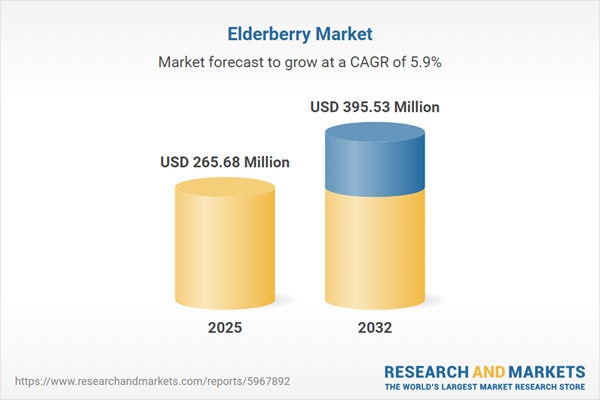Speak directly to the analyst to clarify any post sales queries you may have.
The elderberry market is in a phase of fast-paced evolution, with industry leaders focusing on regulatory compliance, supply chain resilience, and adapting products to changing consumer and market dynamics. Companies are recalibrating strategies to remain competitive against a backdrop of shifting standards and customer preferences.
Elderberry Market Snapshot: Size and Growth Outlook
The global elderberry market is forecast to expand notably, reaching USD 265.68 million in 2025 from USD 250.80 million in 2024, and projected to climb to USD 395.53 million by 2032. Fueled by a 5.85% compound annual growth rate, this trajectory is driven by increasing demand for plant-based nutrition and new ingredient extraction techniques. Senior executives face a dynamic landscape marked by strong sustainability expectations, rigorous regulatory oversight, and heightened rivalry. Market participants are adjusting product portfolios, tracking policy changes, and establishing stronger positions in the food, beverage, and nutraceutical segments to remain relevant.
Scope & Segmentation: Strategic Dimensions in the Elderberry Market
This market research provides essential intelligence for senior decision-makers planning corporate strategy, investments, and organizational adaptability. The following critical segments offer targeted insights to define market positioning and future opportunities:
- Application: Addresses dietary supplements, food and beverages, personal care, and pharmaceutical use cases, facilitating the identification of potential partnerships and innovations geared for both B2B and B2C contexts.
- Product Form: Encompasses capsules, syrups, powders, tablets, and gummies; each reflects manufacturing versatility and helps organizations select the right delivery format to match emerging consumer preferences.
- Distribution Channel: Spotlights digital and physical retail, e-commerce, third-party and conventional retail, and pharmacy routes, empowering executives to explore diverse paths to market and broaden their reach efficiently.
- Source: Considers both conventional and organic approaches, helping organizations refine procurement strategies and enhance brand positioning through sustainable practices.
- End User: Covers product targeting for adults, pediatric, and senior consumers, supporting the development of segmented marketing initiatives that address specific end user requirements.
- Regions: Reviews opportunities and regulations across the Americas, Europe, Middle East, Africa, and Asia-Pacific, emphasizing the need for regionally tuned strategies, local compliance, and insight into consumer behaviors.
- Competitive Landscape: Focuses on comparative analysis among established market leaders, emphasizing technological progress in extraction processes and manufacturing innovations that drive incremental differentiation.
Elderberry Market: Key Takeaways for Senior Decision-Makers
- Implementing clean-label and transparency initiatives helps organizations adapt proactively to changing regulations while strengthening trust with stakeholders and partners.
- Expanding presence in both digital and traditional retail channels allows businesses to address evolving customer purchasing habits and unlock new consumer access points.
- Investing in extraction and encapsulation advancements leads to higher product consistency, improved operational efficiencies, and the creation of value-added B2B partnerships.
- Deploying demographic and application-based segmentation strategies increases agility in targeting key market niches and supports more effective integration with allied industries.
- Maintaining robust monitoring of global policy developments ensures that organizations are positioned to respond swiftly and maintain uninterrupted market operations.
- Prioritizing responsible sourcing and ethical procurement builds stronger supplier alliances, resonating with clients who value sustainable supply chains and corporate responsibility.
Impact of United States Tariffs on the Elderberry Supply Chain
New United States tariffs scheduled for 2025 are driving companies to reevaluate and diversify elderberry supply chain partnerships. Organizations are responding to anticipated cost pressures by enhancing relationships with both domestic and international suppliers. Emphasis on organic and sustainable sourcing sets leading companies apart, while collaborative supplier management and a focus on process efficiency support stability in an uncertain policy environment.
Research Methodology & Data Sources
This analysis applies a blend of primary interviews with procurement, innovation, and retail stakeholders, combined with focused secondary research. Data triangulation assures senior executives of reliable, actionable insights that support informed decision-making for organizational growth.
Why This Elderberry Market Report Matters
- Enables executive teams to recalibrate strategies efficiently as regulations and consumer trends evolve in the elderberry sector.
- Supports strategic expansion into new regions through granular segmentation and compliance analysis, helping optimize routes to market and mitigate risk.
- Drives operational enhancement by promoting digital transformation initiatives, sustainable sourcing, and process improvements for a measurable competitive edge.
Conclusion
Investment in resilient, technology-enabled supply chains—combined with a focus on compliance and sustainability—enables organizations to navigate the advancing elderberry market and stay prepared for emerging challenges and opportunities.
Additional Product Information:
- Purchase of this report includes 1 year online access with quarterly updates.
- This report can be updated on request. Please contact our Customer Experience team using the Ask a Question widget on our website.
Table of Contents
3. Executive Summary
4. Market Overview
7. Cumulative Impact of Artificial Intelligence 2025
Companies Mentioned
The companies profiled in this Elderberry market report include:- Indena S.p.A.
- Euromed S.A.
- Diana Food (Groupe Roullier)
- Symrise AG
- Kerry Group plc
- Archer-Daniels-Midland Company
- Cargill, Incorporated
- International Flavors & Fragrances Inc.
- Layn Natural Ingredients Co., Ltd.
- Sabinsa Corporation
Table Information
| Report Attribute | Details |
|---|---|
| No. of Pages | 199 |
| Published | October 2025 |
| Forecast Period | 2025 - 2032 |
| Estimated Market Value ( USD | $ 265.68 Million |
| Forecasted Market Value ( USD | $ 395.53 Million |
| Compound Annual Growth Rate | 5.8% |
| Regions Covered | Global |
| No. of Companies Mentioned | 11 |









